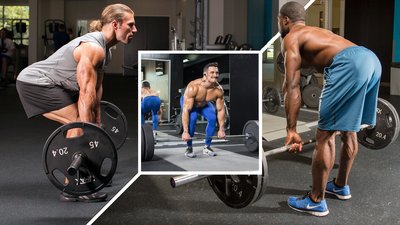The Romanian deadlift arguably is performed incorrectly more often than any other exercise. People confuse it with the stiff-legged deadlift or the conventional deadlift, or mix them together to make a mashed-up version of all three. The resulting "Frankenlift" may not be working the right muscles the right way, and it might even injure you.
So let's see how well you know one deadlift from another. Answer these five multiple-choice questions to the best of your ability, after which we'll explain the correct answers.
1. The Romanian deadlift starts
a) with the bar on the ground
b) with the bar at hip level
c) with the bar at knee level
2. The Romanian deadlift effectively hits
a) upper hamstrings and glutes
b) your entire posterior chain
c) quads
3. To initiate the Romanian deadlift, start by bending over at the
a) waist
b) hips
c) it doesn't matter
4. As you approach the bottom position of a Romanian deadlift, the barbell should travel down your legs
a) close to your shins
b) away from your shins
5. When you're doing a Romanian deadlift, the barbell should touch the floor between every rep.
a) true
b) false
c) either way is fine
ANSWERS
1. (b) If you think the bar rests on the ground at the start of a Romanian deadlift, you're confusing it with the conventional deadlift. The Romanian deadlift starts at the top of the range of motion, at the hips. The conventional lift starts at the bottom.
2. (a) When done correctly, the Romanian deadlift is a single-joint move (albeit with some additional movement in the knees) that works the upper hamstrings and glutes. The conventional deadlift works your posterior chain.

3. (b) First, let's be clear on the difference between these two parts of your anatomy: The hip joint is where the thigh bone meets the pelvis. The waist is generally referred to as the area below the ribs but above the hips, and crosses the lower region of the rectus abdominis.
The correct Romanian deadlift form is to keep your lower back flat. This helps protect the discs of your spine. To do that, you must bend at the hip so that your erector spinae (lower-back muscles) stay in isometric contraction. If you bend at the waist, your abdominals shorten (contract) while your erectors lengthen (stretch).
There's no way you can both isometrically contract and lengthen your erectors at the same time. Bending at the hips allows you to maintain a flat back throughout.
4. (a) To perform a Romanian deadlift correctly, the bar should travel very close to your legs throughout the movement. If the bar strays from your body, your lower back gets more involved, which, in this case, is not good.
Your lower back should be more engaged when you're doing a stiff-legged deadlift. But you do these with much lower weights than you do Romanian deadlifts, so your back is better protected.
5. (b) Protect your lower back while doing a Romanian deadlift by keeping your legs fairly straight and lowering the bar no further than mid-shin (though some people with exceptional flexibility may be able to go lower).
If you try to go too much further than mid-shin on a Romanian deadlift, you're likely to round your back. Again, this puts the discs in your spine at risk. What's more, by keeping the plates off the floor, you also keep tension on the target muscles.

